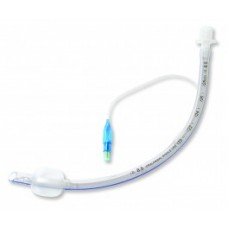ENDOTRACHEAL TUBE - STANDARD CUFFED 3.0MM, EACH (AN021000)
- Brand: Multigate Devices
- Product Code: AN021000
-
Ex GST: AU$5.50
ENDOTRACHEAL TUBE - STANDARD CUFFED
An Endoracheal tube is a catheter that is inserted into the trachea for the primary purpose of establishing and maintaining a patent airway and to ensure the adequate exchange of oxygen and carbon dioxide.
General Information :
An endotracheal tube is a breathing tube. It is used temporarily for breathing because it keeps your airway open. This curved tube is placed through the patient's nose or mouth into his trachea (windpipe). Tape or a soft strap holds the tube in place.
Types of endotracheal tube include oral or nasal, cuffed or uncuffed, preformed (e.g. RAE (Ring, Adair, and Elwyn) tube), reinforced tubes, and double-lumen endobronchial tubes. For human use, tubes range in size from 2 to 10.5 mm in internal diameter (ID). The size is chosen based on the patient's body size, with the smaller sizes being used for pediatric and neonatal patients. Tubes larger than 6 mm ID usually have an inflatable cuff.
An endotracheal tube is used :
· To attach a ventilator if the patient is unable to breathe on its own.
· To keep the patient's trachea (windpipe) open.
· To allow the staff to remove mucus from the patient's lungs that he is unable to cough up himself.
Things to Know When The Patient has An Endotracheal Tube
· The endotracheal tube passes through the patient's vocal cords. This means that the patient will not be able to speak while the tube is on his throat. The patient can mouth words, write notes or use gestures.
· While the patient has the endotracheal tube in place he may not eat or drink because it may cause choking. He will receive fluid and nutrition through an intravenous (IV) or stomach tube. The nursing staff will give him wet swabs if his mouth is dry.
· The nurse or respiratory therapist will suction the patient's endotracheal tube from time to time. This is done to remove mucus from the patient's lungs. Suctioning will cause him to cough. The patient also may feel short of breath for several seconds. He will be given extra oxygen during suctioning to help decrease the short - of - breath feeling.
· The endotracheal tube will be removed when the patient's doctor feels that he can breathe well by himself. He will be given oxygen after the endotracheal tube is removed. The oxygen may be given through a face mask or soft plastic prongs placed just inside the patient's nose. The nurse will remind the patient to breathe deeply and cough. The patient's voice may be hoarse, but the hoarseness will gradually decrease.
How is the breathing tube held in place?
The breathing tube is held in place with tape or a plastic device. The nurses and respiratory therapists secure the tube with tape. The tape extends around the neck to form a circle of tape holding the tube in place.
Can the patient talk with the breathing tube in place?
No. The breathing tube goes through the vocal cords and prevents them from moving. This means the patient cannot make sounds.
How long is a breathing tube used?
Normally, breathing tubes are used only for a short time until patients can breath on their own. If the patient needs a breathing tube for more than a few days, the doctor may want to put a temporary tracheostomy tube in the patient's neck. The tracheostomy tube is usually more comfortable than an endotracheal tube.
Does a breathing tube hurt?
Initially, most patients complain about the breathing tube feeling uncomfortable. It often makes patients cough or gag. Over the time the patients get used to the tube and the initial discomfort fades.
Are there any complications associated with use of a breathing tube?
Breathing tubes can become displaced and may require reinsertion. This most commonly happens if the patient is agitated and vigorously moving. Some patients attempt to remove the tubes themselves. This is one of the reasons that patient's hands are gently restrained and mild sedation is used.
Tags: Anaesthesia, Oxygen Therapy, Respiratory System, ETT, Intubation

